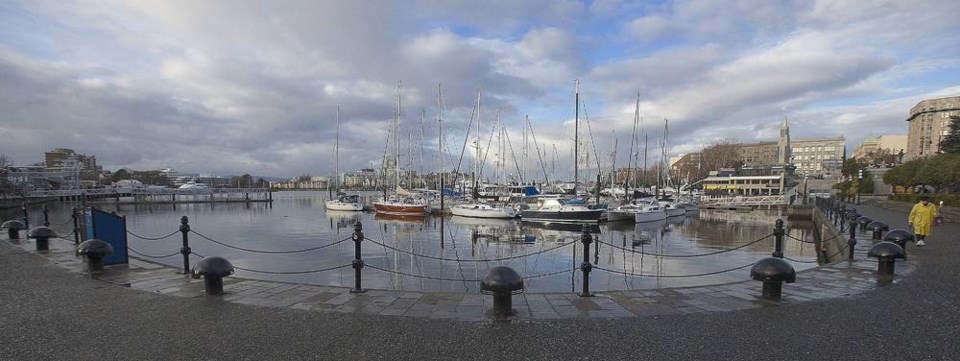The other day, I strolled downtown by way of the Inner Harbour along the Lower Causeway.
It was one of those lovely sunny autumnal mornings; a few people, maybe Alberta tourists, were taking selfies in front of the cluster of white sailboats, their bare masts a sky of cabled triangles; the city workers were removing all the red begonias that spelled Welcome To Victoria from the grassy slope (“Way too soon!” I thought, “those begonias still look very succulent!”).
I saw a man tossing a long rope into the harbour, quite close to the boats, and pulling it back almost instantly but slowly, letting it drag through the muddy sea bottom under the murky greenish water. On the end of the rope was a large metal object which, as it turned out, was a magnet.
The man had placed a little square towel on top of the black enamelled “mushroom” lights that line the causeway, and on the towel was a diverse collection of corroded coins and other intricate pieces of metal debris all neatly wiped off, separated and organized.
I do not know if there was treasure found from his venture, but it reminded of me of a wonderful little book, (available in most bookshops) Victoria Underfoot, Excavating a City’s Secrets by editors Brenda Clark, Nicole Kilburn, and Nick Russell (Harbour Publishing, 2008).
The book is a selection of easy-to-read fascinating essays by various local heritage, anthropological and archeological experts, each explaining what lies beneath our city streets, hospital sites, parks and farmlands, or deep in the mud of our waterways, shores and river banks.
The book is a significant historical source of the social and economic growth of Victoria, including a very sensitive account of the First Nations and Chinese sites and cultural traditions that, thanks in part to our historians and their findings, have given us a deeper understanding of culture other than colonial.
Relying on minor excavations and archeological findings, as well as exploring numerous underground caverns, dried stream beds and tunnels that lurk below what we see, this glossy little book, which is full of photographs, maps and other data (such as the stratigraphy of Esquimalt Lagoon or how ground-penetrating radar works), gently informs us of a history that many of us may not have ever been aware of.
Under Victoria’s Sidewalks by Janis Ringuette is a particularly vivid description of what was quietly but busily bustling under those purple glass squares embedded into the concrete along Broad, Broughton and Fort streets.
These glass prisms used to be transparent, so why today is the glass purple? The manganese used in the manufacture of glass at that time (1900 to 1914) oxidized in the sun over the years, turning the clear glass into the magenta shades you tread upon today.
Excavating The Provincial Royal Jubilee Hospital Dump: Taking In The Garbage A Hundred Years Later by Grant Keddie (Royal B.C. Museum) describes the artifacts deposited as garbage in the late 1800’s at the site of our Royal Jubilee Hospital.
The Pemberton Memorial Operating Room (the first operating room north of San Francisco, says the essay), hexagonal in shape, functioned from 1896 to 1925. Little relics, such as porcelain doll parts, blue glass arsenic bottles (recognized by their eight sides) and a cherry toothpaste container emblazoned with Queen Victoria’s portrait were dug up over the years when the Royal Jubilee was renovated.
The operating theatre is now a registered heritage building (and worth a visit when COVID-19 is over).
But how about artifacts and relics in your own home? This may be a good time to clean them up!
Here is a super little book to assist you, Tales From The Attic, Practical Advice on Preserving Heirlooms and Collectibles, by Colleen Wilson (Royal British Columbia Museum, 2002).
These helpful chapters cover everything from how to remove stains from a whalebone corset to preserving grandmother’s beautiful opal broach — keep it out of sunlight or it may crack.
I discovered how to clean Mum’s old (extremely stiff) wool army jacket which I retrieved from her attic after she died — her little feral cat Gracie had birthed kittens on it!
Mum was the only uniformed female war artist sent over to paint the scenes of barrack life during the Second World War (Dad went as well but was sent to the front) — her jacket is tiny — she must have only weighed 90 pounds!
Taking care of your family history is a COVID-friendly activity that you can do at home — wash your hands first.
And, if you need to store a skeleton, “choose a closet on an inside wall.”



